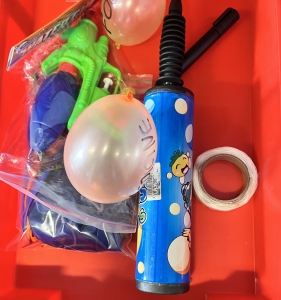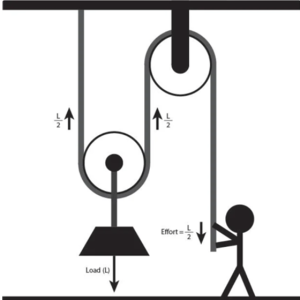Description
The contents of this kit will allow you to build the balloon pulley system Scientific Sue uses in her Devastatingly Dramatic Climate Show.
What’s in the kit
- 4 doughnut balloons
- 6 long double-sided stickers
- 10 modelling balloons
- 4 small (5″) balloons
- 10 Water balloons
- 10 Small double-side stickers
- Small water pistol
What you need:
- Balloon pump
- Air zooka**
- Safety glasses
- Permanent pen
- 2 x trays for the water balloon parcels
- 6 paper/plastic cups
Secrets for Success
- Blow up the 4 doughnut balloons – These will make the two pulleys. The two balloons of the same colour are joined together by the double-sided stickers (3 stickers per set. Have spare sticky dots, stickers to hand).
- Blow up the four 5” balloons to a size that the children will be able to hold comfortably.
- Tie two of the model balloons to two of the 5” balloons. Thread the model balloons down the middle of the pair of doughnut balloons. If the model balloon isn’t long enough, add another – this one has to be removed before you tie the other 5” balloons to the model balloons to complete the 2 pulley units.
- When the small balloons are pulled apart the doughnut ‘pulley’ should spin on the stretched (uninflated) model balloon, when you give a downward tap.
- Depending on the size of your room, inflate 6 or 8 modelling balloons and join them together to form a loop – this will be the rope that goes over the 2 ‘pulleys’.
- Inflate 6 of the water balloons.
- You may want to write on each of them: food, water, medicine, etc.
- Put one small sticky tab on the bottom of the balloons – make sure the protective cover is removed on both ends of the tab – otherwise the balloons won’t stick to the balloon rope.
- To prevent them from sticking together and blowing away put them into the 6 paper cups – if the workshop option was purchased used the cups provided.
You will be guided on how to construct the pulley system by me in the video.
Fill your water pistol – if the one in the box isn’t big enough by all means add your own!
In the video I suggest that you the teacher use the water pistol, you will be the rain in the storm.
If you have an airzooka I will also guide you to choose a 5th volunteer who will be the wind in the storm. Have them stand between 1-2 m away from the other volunteers. Guidance must be given not to release air into anyone’s eyes – safety googles are recommended.
Science in a Nutshell
A pulley is simply a collection of one or more wheels over which you loop a rope to make it easier to lift and/or move things.
Pulleys are examples of what scientists call simple machine. That doesn’t mean they’re packed with engines and gears; it just means they help to make work easier for us and can even help us multiply forces. If you want to lift a really heavy weight, there is only so much force ore muscles can supply, even if you are extremely strong. However, by using a simple machine such as a pulley you can change the direction of the pulling force (and use gravity to help with the lift) and with increasing numbers of pulley wheels can effectively multiply the force your produces.
The more wheels you have, and the more times your loop the rope around them, the more you can lift.
One Wheel
If you have a single wheel and a rope, a pulley helps you reverse the direction of your lifting force.
So, as in the picture below, you pull the rope down to lift the weight up. If you want to lift something that weighs 100kg, you have to pull down with a force equivalent to 100kg, which is 1000N (newtons). If you want to raise the weight 1m into the air, you have to pull the loose end of the rope a total distance of 1m at the other end.
Two Wheels
Now if you add more wheels, and loop the rope around them, you can reduce the effort you need to lift the weight. Suppose you have two wheels and a rope looped around them, as
in the figure below. The 100kg mass (1000 newton weight) is now effectively supported by two sections of the same rope (the two strands on the left) instead of just one (ignoring the loose end of the rope you’re pulling with), and this means you can lift it by pulling with a force of just 500 newtons—half as much! That’s why we say a pulley with two wheels, and the rope wrapped around it this way, gives a mechanical advantage (ME) of two.
Mechanical advantage is a measurement of how much a simple-machine multiples a force. The bigger the mechanical advantage, the less force you need, but the greater the distance you have to use that force. The weight rises 1m, but now we have to pull the loose end of the rope twice as far (2m). How come? To make the weight rise 1m, you have to make the two sections of rope supporting it rise by 1m each. To do that, you have to pull the loose end of the rope 2m. Notice that we can also figure out the mechanical advantage by dividing the distance we have to pull the rope by the distance the weight moves.
A block and tackle is a cable system primarily found on cranes and boats that involves two pulleys and a cable or rope. The mechanism consists of one fixed pulley and one movable, usually hanging, pulley. A single rope is fixed to on or near the carriage of the fixed pulley, loops down and around the movable pulley, then back up and around the fixed pulley. A hook is attached to the underside of the movable pulley, and by tugging on the rope, the hook will lift or lower.














